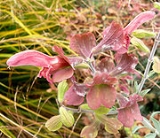
Salvia lanceolata
Encyclopedia
Salvia lanceolata is a perennial shrub native to a small area of coast on the Cape of Good Hope
in South Africa
. It is typically found growing in sandy ground at sea level, and on dry hills and flat ground up to 1000 feet elevation. Jean-Baptiste Lamarck
, a pioneer in evolutionary theory, first described and named the plant "lanceolata" in 1791. Swedish botanist Carl Peter Thunberg
, who was delayed in South Africa on the way to Japan, first collected it nearly twenty years earlier, along with approximately 3,000 plants that he later described. It wasn't until 1800 that Thunberg gave the plant the specific epithet "nivea", to honor Scottish gardener and plant collector James Niven. Because of the rules of nomenclature, Lamarck's name had precedence because he was the first to name it.
Salvia lanceolata is a much branched shrub growing 3 ft tall and 2-4 ft wide, with stems that become woody and light tan as they age. The leaves are lanceolate
and evergreen, thick textured, and dove-gray with a green undertone. The .5 inch long calyx expands to 1 inch after the flowers are fertilized, turning pink. The 1.5 inch flowers are an unusual dull rosy brownish color. The plant blooms sparsely over a long period, from May through November.
When crushed, the leaves give off a light fragrance reminiscent of lemon pepper, and are used in South Africa for cooking, most commonly with fish.
Cape of Good Hope
The Cape of Good Hope is a rocky headland on the Atlantic coast of the Cape Peninsula, South Africa.There is a misconception that the Cape of Good Hope is the southern tip of Africa, because it was once believed to be the dividing point between the Atlantic and Indian Oceans. In fact, the...
in South Africa
South Africa
The Republic of South Africa is a country in southern Africa. Located at the southern tip of Africa, it is divided into nine provinces, with of coastline on the Atlantic and Indian oceans...
. It is typically found growing in sandy ground at sea level, and on dry hills and flat ground up to 1000 feet elevation. Jean-Baptiste Lamarck
Jean-Baptiste Lamarck
Jean-Baptiste Pierre Antoine de Monet, Chevalier de la Marck , often known simply as Lamarck, was a French naturalist...
, a pioneer in evolutionary theory, first described and named the plant "lanceolata" in 1791. Swedish botanist Carl Peter Thunberg
Carl Peter Thunberg
Carl Peter Thunberg aka Carl Pehr Thunberg aka Carl Per Thunberg was a Swedish naturalist and an apostle of Carl Linnaeus. He has been called "the father of South African botany" and the "Japanese Linnaeus"....
, who was delayed in South Africa on the way to Japan, first collected it nearly twenty years earlier, along with approximately 3,000 plants that he later described. It wasn't until 1800 that Thunberg gave the plant the specific epithet "nivea", to honor Scottish gardener and plant collector James Niven. Because of the rules of nomenclature, Lamarck's name had precedence because he was the first to name it.
Salvia lanceolata is a much branched shrub growing 3 ft tall and 2-4 ft wide, with stems that become woody and light tan as they age. The leaves are lanceolate
Leaf shape
In botany, leaf shape is characterised with the following terms :* Acicular : Slender and pointed, needle-like* Acuminate : Tapering to a long point...
and evergreen, thick textured, and dove-gray with a green undertone. The .5 inch long calyx expands to 1 inch after the flowers are fertilized, turning pink. The 1.5 inch flowers are an unusual dull rosy brownish color. The plant blooms sparsely over a long period, from May through November.
When crushed, the leaves give off a light fragrance reminiscent of lemon pepper, and are used in South Africa for cooking, most commonly with fish.

